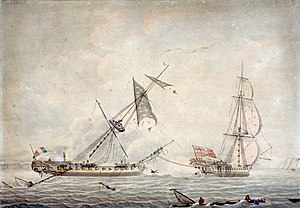 HMS Blanche tows the captured Pique into port, depicted by Robert Dodd
| |
| History | |
|---|---|
| Name | HMS Blanche |
| Ordered | 9 August 1782 |
| Builder | Thomas Calhoun & John Nowlan, Bursledon |
| Laid down | July 1783 |
| Launched | 10 July 1786 |
| Completed | By 25 April 1789 |
| Honours and awards | Naval General Service Medal with clasp "Blanche 4 Jany. 1795"[1] |
| Fate |
|
| General characteristics | |
| Class and type | 32-gun Hermione-class fifth rate |
| Tons burthen | 722 48⁄94 bm |
| Length |
|
| Beam | 35 ft 7+1⁄2 in (10.9 m) |
| Depth of hold | 12 ft 7 in (3.84 m) |
| Propulsion | Sails |
| Sail plan | Full-rigged ship |
| Complement | 220 |
| Armament |
|
HMS Blanche was a 32-gun Hermione-class fifth rate of the Royal Navy. She was ordered towards the end of the American War of Independence, but only briefly saw service before the outbreak of the French Revolutionary Wars in 1793. She enjoyed a number of successful cruises against privateers in the West Indies, before coming under the command of Captain Robert Faulknor. He took the Blanche into battle against a superior opponent and after a hard-fought battle, forced the surrender of the French frigate Pique. Faulknor was among those killed on the Blanche. She subsequently served in the Mediterranean, where she had the misfortune of forcing a large Spanish frigate to surrender, but was unable to secure the prize, which then escaped. Returning to British waters she was converted to a storeship and then a troopship, but did not serve for long before being wrecked off the Texel in 1799.
- ^ "No. 20939". The London Gazette. 26 January 1849. p. 237.
